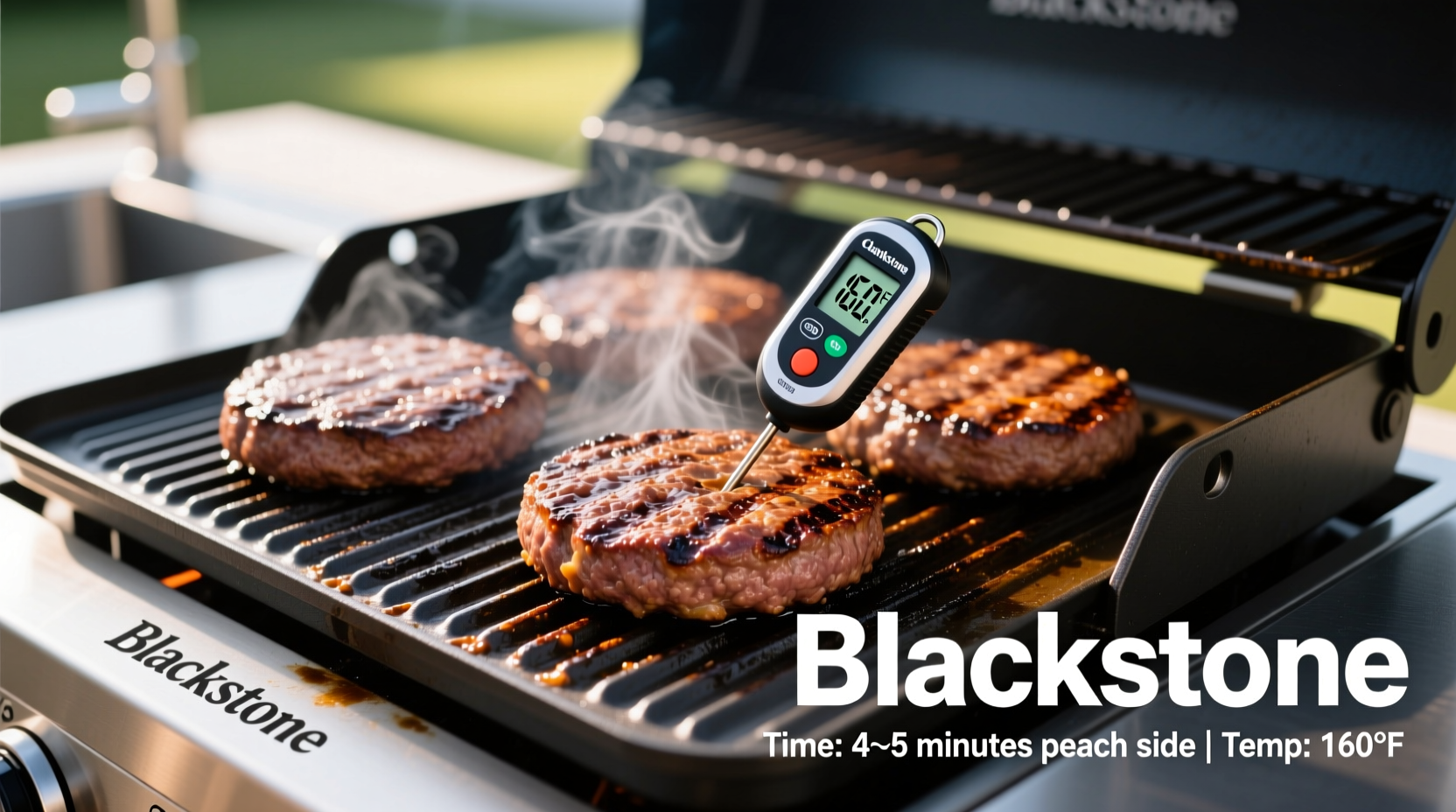The Science Behind Perfect Blackstone Burger Timing
Getting burger timing right on your Blackstone griddle isn't just about minutes on the clock—it's about understanding the interplay between heat transfer, meat composition, and visual cues. Unlike traditional grills, Blackstone's solid cooking surface creates consistent contact that sears faster but requires precise timing to avoid overcooking.

How Long to Cook Burgers on Blackstone: The Essential Framework
While many variables affect cooking time, this baseline guide works for standard 1/2-inch thick, 4-ounce patties on a properly preheated Blackstone:
| Doneness Level | Time Per Side | Internal Temperature | Visual Indicators |
|---|---|---|---|
| Medium-Rare | 2.5-3 minutes | 130-135°F | Warm red center, slight resistance when pressed |
| Medium | 3-4 minutes | 140-145°F | Pink center, springy texture |
| Medium-Well | 4-5 minutes | 150-155°F | Small pink area, firm texture |
| Well-Done | 5-6 minutes | 160°F+ | No pink, very firm texture |
Important: These times assume your Blackstone is preheated to 375-400°F. The USDA recommends cooking ground beef to 160°F for food safety, but many home cooks prefer medium (145°F) for better flavor and juiciness when using fresh, high-quality meat.
Four Critical Factors That Change Your Cooking Time
1. Patty Thickness Matters Most
A 1/2-inch patty cooks significantly faster than a 1-inch "gourmet" burger. For every additional 1/4 inch of thickness, add 1-1.5 minutes per side. Thicker patties need slightly lower heat (350°F) to cook through without burning the exterior.
2. Blackstone Temperature Variations
Blackstone surfaces aren't perfectly uniform in temperature. The center typically runs 25-50°F hotter than the edges. Always test with a single patty first and adjust placement—move toward cooler zones for thicker burgers needing longer cooking.
3. Meat Composition and Starting Temperature
Higher fat content (80/20) burgers cook faster than leaner blends (90/10) because fat renders and conducts heat more efficiently. Chilled patties straight from the refrigerator add 30-60 seconds to initial cooking time compared to room-temperature meat.
4. Environmental Conditions
Cold outdoor temperatures (below 50°F) can drop your Blackstone's effective cooking temperature by 50°F or more, requiring longer cooking times. Windy conditions create similar cooling effects. Always allow extra preheating time in challenging conditions.
Step-by-Step Blackstone Burger Cooking Process
Preparation Phase (5 Minutes)
Preheat your Blackstone for 10-15 minutes to 375-400°F. Season patties just before cooking—salt too early draws out moisture. Create a slight dimple in the center of each patty to prevent bulging during cooking.
Cooking Sequence (Critical Timing)
- First Sear (3 minutes): Place patties on hot surface. Don't press down—that squeezes out juices. Wait until edges turn opaque about 1/3 up the sides before flipping.
- Flip and Cheese (2-3 minutes): Flip once, add cheese if desired. The second side typically cooks faster due to residual heat buildup.
- Resting (3-5 minutes): Transfer to a wire rack—never directly to a plate. Resting allows juices to redistribute, preventing dry burgers.
Troubleshooting Common Timing Issues
"My burgers are burnt outside but raw inside!"
This happens when your Blackstone is too hot (over 425°F). Next time, reduce heat to 350°F and extend cooking time by 30-60 seconds per side. The Maillard reaction (browning) occurs faster than protein denaturation (cooking through).
"They're sticking to the griddle!"
Patience solves 90% of sticking issues. Wait until you see clear separation between the patty and surface before attempting to flip. Proper preheating and oiling (use high-smoke point oils like avocado) prevent most sticking problems.
Pro Tips for Perfect Blackstone Burgers Every Time
- Use an instant-read thermometer—timing alone isn't reliable. Insert horizontally from the side for accurate readings.
- Cook in batches with proper spacing—crowding lowers surface temperature and creates steam that prevents proper searing.
- Add moisture-rich ingredients like Worcestershire sauce or grated onion directly to the meat for juicier results, especially with lean blends.
- Oil the meat, not the griddle—coating patties with oil before cooking creates better sear without excessive smoking.
When Standard Timing Doesn't Apply
These timing guidelines work for traditional ground beef patties but require adjustment for:
- Turkey or chicken burgers: Need higher internal temperature (165°F) and typically 1-2 minutes longer per side due to leaner composition
- Veggie burgers: Cook at lower heat (325°F) for 4-5 minutes per side—they lack fat to conduct heat efficiently
- Stuffed burgers: Add 1-2 minutes per side to ensure fillings reach safe temperatures











 浙公网安备
33010002000092号
浙公网安备
33010002000092号 浙B2-20120091-4
浙B2-20120091-4